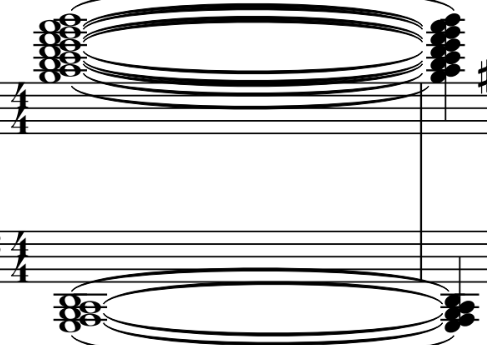Leaderboard
Popular Content
Showing content with the highest reputation on 11/02/2025 in Posts
-
This is just a reminder post for those wishing to receive an "Ardent Reviewer" badge that by Monday 11:59 pm PST you might still need to review some works! @Omicronrg9, @Wieland Handke, @Henry Ng Tsz Kiu, @chopin, and myself @PeterthePapercomPoser have reviewed all the entries (minus their own) and will receive the "Ardent Reviewer" badge! @TristanTheTristan - you still need to review Thatguy's piece and the last five pieces in the list. You will receive the "Ardent Reviewer" badge! @HoYin Cheung - you've only reviewed two pieces. Do you still intend to review the rest? @UncleRed99 - you still need to review Omicronrg9's piece and the last six pieces in the list. @Kvothe - you still need to review Maxthemusicenthusiast's piece and UncleRed99's piece. You will receive the "Ardent Reviewer" badge! @MK_Piano - you still need to review sebastian Pafundo's, Maxthemusicenthusiast's, Kvothe's, Thatguy v2.0's, and the last five pieces. @Thatguy v2.0 - you still need to review Micah's and Dima's pieces. @therealAJGS - you still need to review Maxthemusicenthusiast's, TristanTheTristan's, and the last two pieces. You will receive the "Ardent Reviewer" badge! @Cosmia - you've only reviewed three pieces. Do you still intend to review the rest? Of course, we're all grateful for your time and your willingness to review however much you want to! Thank you for making this competition fun and instructional for everyone!4 points
-
And... I am done! Thank you and good job to everyone who has joined the competition! I am looking forward for the Christmas Competition!2 points
-
Do you want to take some maths lessons from me? PLEASE............................................................ Anyways, to my scorings: Melodies Themes Motives Harmony Chords Textures Form Development Structure Time Originality Creativity Score Presentation Instrumentation Orchestration Playability Execution of Given Challenge Taste 7 7 8 7 10 9 7 8 Average: 7.875 Average2 points
-
Variations on Dies Irae.mp3 I haven't quite been feeling the compositional drive recently, but I did try writing something for one of the informal group competitions over on MuseScore that I'd thought I'd share here as well. I would have definitely liked to write more variations but I was kinda lazy and went with three, which I hope contrast well with each other. I'm always revising my work, so is there anything that you like/dislike about this? As a pianist, I'm also not good at composing for string instruments (this is my...second ever attempt at a string quartet work?) and would be happy to receive feedback on my string writing too! I feel like I may have been too enthusiastic with the slurs and probably should remove a bunch of them... Variations on Dies Irae.pdf1 point
-
1 point
-
I LOVE variations. Webern isn't necessarily my favorite composer musically, but philosophically, the ability to say a lot with a little is definitely my style. I think you've done the same thing here. That being said, I'd actually suggest you make the Theme a little longer. Even Paganini's 24th Caprice theme has a clear A and a B section despite being so short and I think it really helps to balance the rest of the piece. Whether or not you incorporate it a lot into the other variations is up to you, obviously, but starting with something a little fuller might be nice. Who knows, you appear to be proficient enough to maybe even try to see if you can notice any commonalities in your variations and derive a B-section theme from that; that would be super cool if you could. Generally speaking, this is super wonderful to listen to, you should be very happy with it! I'm always a sucker for good counterpoint, so I think I like Variation 1 the best, but Variation 2 had so much beautiful stuff (see below). One of the hardest things composers struggle with (myself included!) is balancing moving lines and harmony and you have an excellent command of it! Other stupid taste things that my ears caught when listening: Theme, mm. 5–6: The contrapuntal lines of both V1 and V2 in m. 5 feel like they should convene and the jump in V2 feels a little sudden. A small figure to support that upwards movement could help. Var 1, m. 26: It could just be the soundfont, but is there any way you can throw a G in there? The <F, Bb, C> progression feels oddly quartal amidst the rest of the tonality. Var 1, m. 51: The parallel minor ninths between V2 and Cello that "resolve" to the octave feel a little odd to me, maybe because the supported harmony isn't particularly clear either (not that that's a bad thing). Like, the cello seems to want to support ii˚6, but the upper voices are on v. Var 2, mm. 1–2: In contrast, I love the parallel major sevenths between the cello and viola at the beginning of this variation. Such a strong and confident opening gambit. Var 2, mm. 5, 15: Maybe you're looking for "portamento" in the cello? If I saw glissando, I would think the entire dotted quarter's length would be spent sliding. Var 2, mm. 8–9: Love the little V1 figure! Could be pizz. for a little extra definition? Var 2, mm. 21–end: This is so wonderful. My body got chills and the contrast is so well set-up that the big change felt effortless. Well done! For the cello, if might be worth specifying if you want a rolled pizz. or not, because they'll see that and ask. Var 3: Someone listened to Ravel's quartet, eh? I think, here, the contrast between the tremolo and the rest of it works well, but could be better supported for contrast. The fifth movement of the Ravel, for example, keeps a little tremolo (or basically tremolo) figure throughout to keep that energy up. Even if you don't do that, a line that moves some more would help set the contrast a little better, in my ears—maybe not even the first time, but the second time? Like, the second movement of Symphonie fantastique does that implicitly with a second melody that is inherently faster, with 16th notes.1 point
-
Melodies Themes Motives Harmony Chords Textures Form Development Structure Time Originality Creativity Score Presentation Instrumentation Orchestration Playability Execution of Given Challenge Taste 8 9 9 10 7 0 6 6 DO YOU HAVE 10 FINGERS ON YOUR RIGHT HAND? AND WHAT IS YOUR HANDSPAN? WHERE ARE YOU FROM TO CALL THIS A NATIONAL DANCE?!?!?!!?!?!?!?!?!?!!?!?!?!??!!?!?!?!?!?!?!?!?!?!?!?!?!?!? ANyWaYs,,,,,,,,,,,,,,,,,,,,,,,,, AveRaGE: 6.875 And also I think I got brain damage, so maybe 6.5.1 point
-
Melodies Themes Motives Harmony Chords Textures Form Development Structure Time Originality Creativity Score Presentation Instrumentation Orchestration Playability Execution of Given Challenge Taste 8 8 6.5 9.5 10 8.5 9 9 Average: 8.5625 Above Average1 point
-
Melodies Themes Motives Harmony Chords Textures Form Development Structure Time Originality Creativity Score Presentation Instrumentation Orchestration Playability Execution of Given Challenge Taste 7.5 6.5 8 8.5 10 (nice!) 6.5 7 8 Average: 7.75 Average1 point
-
I wrote a ballet a few years back! Notes aren't too hard since it would've had to been prepared pretty quickly, but I've always been more about screwing around with rhythm and meter, anyway. Forgive the recording quality: I had to make to scratch tracks and I only play cello, so I had to record all the parts except the bass and piano (except the plucking) 😅 Maybe I'll upload the other movements later, but this one is pretty interesting on its own, I think.1 point
-
The harmony and colours I get from this are gorgeous (bar 12 tickles my brain, but all the movements from chord to chord are exquisite), as well as the appearance and disappearance and reappearance of that 'swinging-pendulum' motif, as Henry pointed out. I'm getting extra ideas for what other textures to put in my slow movements with what you've presented in b. 40 🙂, and I have to say that the piano strings from b. 52 onwards are an excellent touch. Seeing that this is just an intermezzo, I'm sure the other movements are just as interesting! I wonder how this fits into the ballet...1 point
-
Hi Ferrum. When I open the PDF window to check it turns out I just cannot. Something's wrong, but not sure if it's in your side or it's the forums, or... Either way I am very curious about the score, duh. This seems to me like a small medley (well maybe not small actually) that contains a wide range of stuff going on but that seems to be permeated by this motif that you don't cease to state and use to transition to all sorts of places. It's like a spring, moving slightly upward and returning, giving birth to new passages endlessly. I must say though that the general feeling this piece gave me was not as concrete as other clear front-runners as you (front-runners to me, obv.). It was enjoyable, anyways! Maybe my shortest review today, but I cannot really find anything to point out about the piece that be worthy of a line or two more, plus I cannot access the score 😞. In summary, I did like some sections more than others, and I didn't feel it very light to be honest! Maybe when put in comparison, you're right. Many thanks for your submission, Ferrum! Kind regards, Daniel–Ø.1 point
-
Dear @ferrum.wav, Heads off to this piece you wrote. Full command of motives, varieties in terms of style, mature chamber writing all are present in your work here! I love the beginning and how you introduce the chromatic motive, as it's accompanied by the tone cluster of piano, as well as the 2nd motive of the dancing motive in b.5. And very nice use of that tremolo too, if adding a sul ponticello would be even better! I simply love how you go from the more atonal beginning to a firming G minor dominant preparation in b.45 with chordal texture, nice combinatio of both tonality and texture for an intro! Nice imitations throughout the main section, and the glissandos throughout are great. I love you bring the opening in b.92 with a quicker tempo. The modulation to D minor in b.122 is very fluent and I like the 2 against 3 rhythmic figure introduce there too. The climax in b.151 is very prepared with consistent imitations, as well as the cool down. I really love J sections with that augurs of dancing motive by Flute, and that nice disturbance with the recurring tremolo in b.206! And the figure in b.212 is naughty! The brillante in b.238 is really brilliant, I would it would be longer! I just go straight to the end. CLearly the end to a Bb minor closure is very CLever. Beware of the tremolo markings though, the 32th note tremolo should be just written with double stroke if it's already a quaver itself. Clearly this one and Vince's piece are both in the very top level. If I'm to judge this whole competition, I will put Vince's piece slightly over yours. In terms of technique you too are great, but Vince's is more heavy in tone which I always like, given how I write heavier music lol! Once again, congrats for writing such a piece! Henry1 point
-
The instrumentation choice, the mixed quintet, was very clever given you the chance of having so many different combinations and colors with the instruments, so that the excessive occurence of the themes never gets boring or repetitive. I must admit that I have discovered the existence of two clear defined (melodic) subjects only upon second listening (and after reading your form description). Maybe I've listened too many atonal music the last few days. With this in mind I would consider it as a polyphonic piece – not a classical fugue – but a combination of counterpuntual theme development, variations and free or homophonic intermezzos which creates a rich and interesting texture that lets the long (more than 7 min) piece pass flowlessly. One of my top favorites. Melodies Themes Motives Harmony Chords Textures Form Development Structure Time Originality Creativity Score Presentation Instrumentation Orchestration Playability Execution of Given Challenge Taste 9 9 9 9 9 9 7 8 Average Score: 8.6251 point
-
Entry: Daunting Steps - Quintet for Piano, Flute, Contrabassoon, Violin and Cello - 2025 Halloween Submission by @ferrum.wav Melodies Themes Motives Harmony Chords Textures Form Development Structure Time Originality Creativity Score Presentation Instrumentation Orchestration Playability Execution of Given Challenge Taste 10 10 10 10 10 10 10 10 Average Score: 10.00 Review: You’re right - your description of this piece being much more lighthearted is an accurate one. It is a playful kind of spooky fun! And the piece coheres well and has very recognizable themes that are well developed and repeated to create a very lucid listening experience. It is sort of dance like too - very much akin to a Siciliana with its dotted 8th note, 16th note, 8th note rhythms. It also seems like a kind of variations fantasy which you’re very well known for composing. There is a great balance of both unity and variety because of this and the piece cements its themes very well into this listeners mind. The ending is quite succinct but effective! It’s actually kind of capricious! Very cute. Another entry that I simply enjoyed listening to over and over. The score is well engraved although I would have displayed some things a bit differently to, in my opinion, “beautify” it. Such as for example some places where you use 16th notes followed by 16th note rests - I would have simply used an 8th note with staccato. But I won’t count you down for such a tiny nitpick. As already mentioned it also fits the Halloween theme quite well. It is perhaps similar in style to Saint-Seans’ “Danse Macabre”. You also used the instrumentation to your full advantage making great use of the contrabassoon. Really can’t say enough good things about this piece! Congratulations!1 point
-
updated. i thought i only needed to use the triple tremolos, or flz., or both. i've chosen to use both to make it clearer. updated to encapsulate the measures that should be played Sul G i'm not sure what this is referring to? if you meant the cello in b.37 where it plays measured tremolos with double stops, i'm pretty sure that's doable unless there's something else to it or i'm just outright referring to the wrong thing it is intended to indicate playing on open strings, not nat. harmonics, hence the "0" fingering. i've changed it to an actual open string symbol now. with the tremolo glissando, i think that's also doable? i've done some searches and have heard that specific playing in a piece i'm pretty sure. can't remember which piece though. fixed fixed changed the run from 16th note triplets to a 9 tuplet for form, it is true that I didn't really think of scherzo while composing form: Introduction: b.1 - b.50, includes both themes playing against each other A: b.51 - b.91 Transition I : b.92 - b.117, includes the intro B: b.118 - b.169 Transition II : b.170 - b.181 Intro*: b.182 - b.223, a variation of the intro A*: b.224 - b. 251, variation of A with change of accompaniment towards the start. Transition I*: b.252 - b.267, variation with added trills. B*: b.268 - b.319 Transition II*: b.320 - b.335 Coda: b.336 - b.359 thanks for the review!! the feedbacks and the comments are really appreciated!!1 point
-
Entry: Daunting Steps Melodies Themes Motives Harmony Chords Textures Form Development Structure Time Originality Creativity Score Presentation Instrumentation Orchestration Playability Execution of Given Challenge Taste 10 9 9.5 10 9 7 10 10 Average Score:9.3 Very good Review: Execution: 10 The entry met the two requirements for this competition: an ensemble for solo instruments with the time frame of 3-7 minutes (with a sweet spot of 5 minutes). Instrumentation : Triple tonging in the woods usually marked with Flz. (flutter tongue). That way, the flutist knows how to tongue the notes. As for String writing: there are some techincal issues to be addressed. First, Sul G marked only one measure. That seems bit confusing. The measure tremolos with double stops...that might be cause playabity issues. the port. to natural harmonics. Also, i am not sure if Arco with tremolo can be achieved then a port. That is rather demanding. In this area, the entry will be score 7. Score presentation: After a careful readful of the score, there notation and engraving errors. There was hair pin that was not algin with the staff. There are rest that 8ths rest that should be quarter rests. The 16h note triplets in compound meter might be misleading. Ergo, the score will 9 Taste: What I like about this entry is that is experiments with idioms that general audience might not be accustom to. There is high sense of chromatism that leads you wonder if this atonal or not. Ferium knows how push beyond traditional harmony and open the door into modern harmony. For that, I will give a 10 Form Development Structure Time There is a clear sense form and structure in this entry. Although it does not use classical structure, which one may be used, you have to know how modern composers use form and structure in new ways. Unlike the traditional sonata forms, this piece is more like Rapsody or similar to scherzo. Both are free forms. I am going to Scherzo in this case, since the meter matches here. (However, I am not sure...if that composer wrote that way). A Scherzo is built like minuet but in 6 or 3. And in this 6/8 with two meterical stress. And that was achieved well. 9.5. Harmony, Textures: The interplay between parts created moody polyphonic and chordal textures. 9 Melodic material The melodic material through this was well devopled. 10 Overall this orginal and creative: 101 point
-
Hi @Monarcheon! Thx for coming back to the forum! We all miss your valuable and detailed insights to our music. As for your music here, I really enjoy it. I absolutely agree with you: the rhythm is so unpredictably flowing with all your use of changing meters, which suggests itself really well as a ballet music. The usage of the rhythmic motive is very organized throughout the whole work. The harmony here actually reminds me of something oriental or Arabic. I really love moments in b.20-21 and b.27-28 when you introduce high register violin writing there, when the register in most of the piece is more in middle/low register, and I hope there's more of that! I also love the use of strings techniques in b.40 section; the sul ponticello tremolo is very effective for the strings, and contrast well with the static note B when there are furious C and A# neighbours. I love the pluck string piano sound in b.52 too, though I would feel bad for the piano if it's played live! A nice ending as well which dies away as it begins. Thx for sharing your music to us! Henry1 point
-
1 point
-
1 point
-
Melodies Themes Motives Harmony Chords Textures Form Development Structure Time Originality Creativity Score Presentation Instrumentation Orchestration Playability Execution of Given Challenge Taste 8.5 7 6.5 8 7.5 7 6 5 Average: 6.9375 Below Average0 points

.thumb.png.8b5b433a341551e913a34392660bc95b.png)









